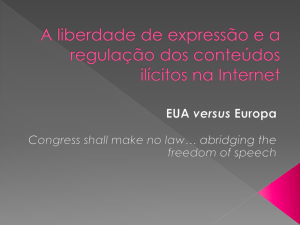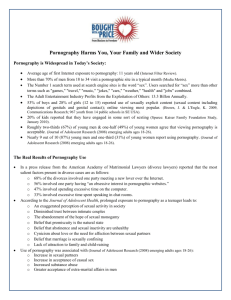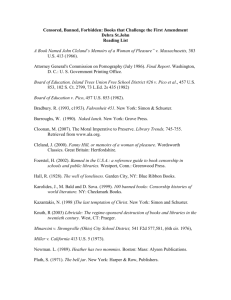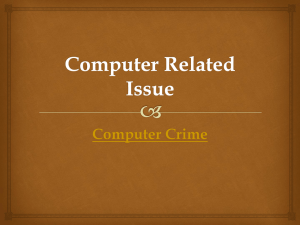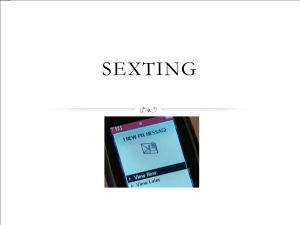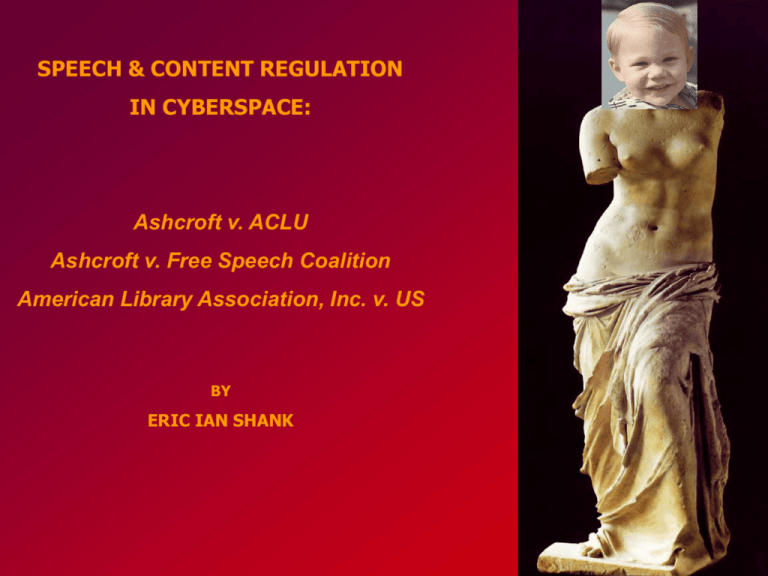
SPEECH & CONTENT REGULATION
IN CYBERSPACE:
Ashcroft v. ACLU
Ashcroft v. Free Speech Coalition
American Library Association, Inc. v. US
BY
ERIC IAN SHANK
Ashcroft v. ACLU
United States Court of Appeals for the Third Circuit held
that the Child Online Protection Act (COPA) violated the
First Amendment because it relied, in part, on community
standards to identify material that was harmful to minors.
Supreme Court held:
Internet's unique characteristics did not justify a different
approach than that previously set forth in federal obscenity
statutes. Any variance caused by the statute's reliance on
community standards was not substantial enough to violate
the First Amendment.
Judgment vacated, case remanded.
Child Online Protection Act
47 U.S. §231
•
Prohibits any person from knowingly making any
communication for commercial purposes on the World Wide
Web that is available to any minor and that includes any
material that is harmful to minors.
•
Defines "material that is harmful to minors" as any
communication, picture, image, graphic image file, article,
recording, writing, or other matter of any kind that is obscene
or that (1) the average person, applying contemporary
community standards, would find, taking the material as a
whole and with respect to minors, is designed to appeal to, or
is designed to pander to, the prurient interest; (2) depicts,
describes, or represents, in a manner patently offensive with
respect to minors, an actual or simulated sexual act or sexual
contact, an actual or simulated normal or perverted sexual act,
or a lewd exhibition of the genitals or post-pubescent female
breast; and (3) taken as a whole, lacks serious literary,
artistic, political, or scientific value for minors.
Ashcroft v. Free Speech Coalition
ΔΔ: Adult Entertainment coalition
Bold Type, Inc. , nudist publication
Jim Gingerich, painter
Ron Raffaelli, erotic photographer
Challenged Child Pornography Prevention Act of 1996 (CPPA) in
Northern District of California.
Issue: “Virtual” child pornography (computer-generated imagery)
Argument: “appears to be” and “conveys the impression”
provisions were so overbroad and vague as to violate 1st
Amendment.
Held: Ban on virtual child pornography is unconstitutional.
The Child Pornography Prevention Act of 1996 (CPPA)
TITLE 18. CRIMES AND CRIMINAL PROCEDURE
PART I. CRIMES
CHAPTER 110. SEXUAL EXPLOITATION AND OTHER ABUSE OF CHILDREN
18 U.S.C. § 2256
(8) "child pornography" means any visual depiction, including any
photograph, film, video, picture, or computer or computer-generated
image or picture, whether made or produced by electronic, mechanical, or
other means, of sexually explicit conduct, where-(A) the production of such visual depiction involves the use of a minor
engaging in sexually explicit conduct;
(B) such visual depiction is, or appears to be, of a minor engaging
in sexually explicit conduct;
(C) such visual depiction has been created, adapted, or modified to appear
that an identifiable minor is engaging in sexually explicit conduct; or
(D) such visual depiction is advertised, promoted, presented,
described, or distributed in such a manner that conveys the impression
that the material is or contains a visual depiction of a minor engaging
in sexually explicit conduct.
United States v. Smith, 795 F.2d 841 (USCA 9th Cir. 1986)
Cert. denied
Smith took photos of three underage girls in various stages of
undressing, engaging in what he called “horseplay”. He later alleged he
was planning to use the pictures in a professional modeling venture.
He mailed the roll of film to a private developer in Maryland. The
company contacted U.S. postal inspectors, who filed an affidavit for a
search warrant. Smith was charged with six violations of 18 U.S.C. §§
2251, 2252. He was convicted on all counts; the decision was affirmed
on appeal.
Influential points of law:
Even undeveloped film constitutes “visual depiction” of "sexually explicit
conduct"
Child pornography statute does not require obscenity
“I can’t define it, but I know it when I see it.”
Miller v. California, 413 U.S. 15 (1973)
Standard for banning obscenity.
Obscene material is unprotected by the First Amendment.
Roth v. United States, 354 U.S. 476 (1957)
The basic guidelines in determining whether material is
obscene are: (a) whether the average person, applying
contemporary community standards would find that the work,
taken as a whole, appeals to the prurient interest, (b) whether
the work depicts or describes, in a patently offensive way,
sexual conduct specifically defined by the applicable state
law; and (c) whether the work, taken as a whole, lacks serious
literary, artistic, political, or scientific value.
New York v. Ferber, 458 U.S. 747 (1982)
Usual obscenity standard does not apply to child pornography.
State’s interest in protecting exploitation and abuse of children.
Paul Ferber, the proprietor of a Manhattan bookstore
specializing in sexually oriented products, sold two films to an
undercover police officer. The films were devoted almost
exclusively to depicting young boys masturbating. Ferber was
found guilty of disseminating child pornography in violation of
New York law.
Government’s position:
There is a direct link between child pornography and child abuse.
Pedophiles may use virtual porn to seduce children.
It is difficult to tell real pictures from virtual or “morphed” images.
Virtual porn provides a loophole for child pornographers to evade
prosecution.
Free Speech Coalition:
The CPPA abridges the freedom of speech.
Virtual pornography is not obscene under the Miller standard,
and does not exploit or abuse children, as in Ferber.
Supreme Court
Expression may not be prohibited just because it is offensive.
The language in the CPPA could also be applied to a Psychology textbook,
Romeo and Juliet or American Beauty.
Teen sex is a fact of modern life, and has been an artistic theme for
centuries.
The CPPA prohibits depictions of persons under the age of 18, whereas in
39 states and the District of Columbia, the age of consent is 16 or
younger. 48 states permit 16 year-olds to marry with parental consent.
Virtual pornography is not intrinsically related to child abuse.
Government cannot premise legislation on “controlling a person’s private
thoughts”. Stanley v. Georgia, 394 U.S. 557 (1969).
Virtual imagery may actually reduce incidence of child exploitation: why
would pornographers risk prosecution if computerized images serve the
same purpose?
Dissent
Just because statutory language could be construed too broadly doesn’t
mean it should or will be. It’s evident that Congress targeted a very
specific and serious problem with this legislation.
Held: §§2256(8)(B) and
2256(8)(D) are overbroad and unconstitutional.
Ban on virtual child pornography violates the 1st Amendment.
Transmitting pictures of pornography involving actual children remains illegal.
Note: Obscenity is regulated separately, in
18 U.S.C.§§ 1460-1466.
American Library Association, Inc. v. US
Plaintiffs—a group of libraries, library associations, library
patrons, and Web site publishers—alleged Childen’s
Internet Protection Act (CIPA) was unconstitutional,
because:
(1) it induced public libraries to violate their patrons' First
Amendment rights contrary to the requirements of South
Dakota v. Dole, 483 U.S. 203 (1987); and
(2) it required libraries to relinquish their First Amendment rights
as a condition on the receipt of federal funds and was
therefore impermissible under the doctrine of unconstitutional
conditions.
South Dakota v. Dole, 483 U.S. 203 (1987)
South Dakota law permitted persons 19 or older to
purchase beer; however, 23 U.S.C. § 158 allowed Congress
to withhold highway funding from any state with a drinking
age of under 21. SD argued the federal statute was
unconstitutional, because it:
(1) violated Congress' spending power under Art. I, § 8, and
(2) induced citizens to engage in unconstitutional activities, in
violation of the 21st Amendment.
Claims rejected at trial and appellate level; Supreme Court
affirmed.
Holding: Congress may use spending power to further secondary goals.
Constitutional test is whether the exercise is in pursuit of the
general welfare. However, Congress may not exercise this
power to further a policy that is inherently unconstitutional.
CHILDREN’S INTERNET PROTECTION ACT
(Pub. L. 106-554)
Passed in an effort to shield children from harmful,
obscene or pornographic content on the Internet.
Required public libraries to install blocking/filtering
software on their computers in order to receive grants
under the Library Services and Technology Act, 20 U.S.C.
§ 9101 ("LSTA"), and "E-rate discounts" for Internet
access and support under the Telecommunications Act, 47
U.S.C. § 254.
TITLE XVII--CHILDREN'S INTERNET PROTECTION
SEC. 1712. LIMITATION ON AVAILABILITY OF CERTAIN
FUNDS FOR LIBRARIES.
SEC. 1721. REQUIREMENT FOR SCHOOLS AND
LIBRARIES TO ENFORCE INTERNET SAFETY POLICIES
WITH TECHNOLOGY PROTECTION MEASURES FOR
COMPUTERS WITH INTERNET ACCESS AS CONDITION
OF UNIVERSAL SERVICE DISCOUNTS.
Holding:
Libraries may create and enforce computer usage policies
governing internet access, but may not infringe on their
patrons’ First Amendment rights. Congress may not deny
funding to schools or libraries because they do not block or
filter patrons’ internet access.
Sections 1712(a)(2) and 1721(b) of the Children's Internet
Protection Act are unconstitutional.
“We find that it is currently impossible, given the Internet's
size, rate of growth, rate of change, and architecture, and
given the state of the art of automated classification systems,
to develop a filter that neither underblocks nor overblocks a
substantial amount of speech.”
CONCLUSIONS
COPA (ACLU)
Previous legal standard for obscenity (see Miller) also
applies on the Internet.
Reliance on “community standards” does not violate
First Amendment.
CPPA (Free Speech Coalition)
“Virtual” child pornography is legal.
CIPA (American Library Association, Inc.)
Congress may not withhold funding from schools and
libraries based on their refusal to abridge patrons’ rights
under the First Amendment.
Food for Thought:
1. How are these three Supreme Court decisions
consistent or inconsistent with each other? Do
they reveal a coherent policy toward content
regulation in Cyberspace?
2. Should any material on the Internet be regulated?
If so, what, how, and by whom?
3. What are the philosophical and public policy
implications of the decriminalization of “virtual”
pornography?

